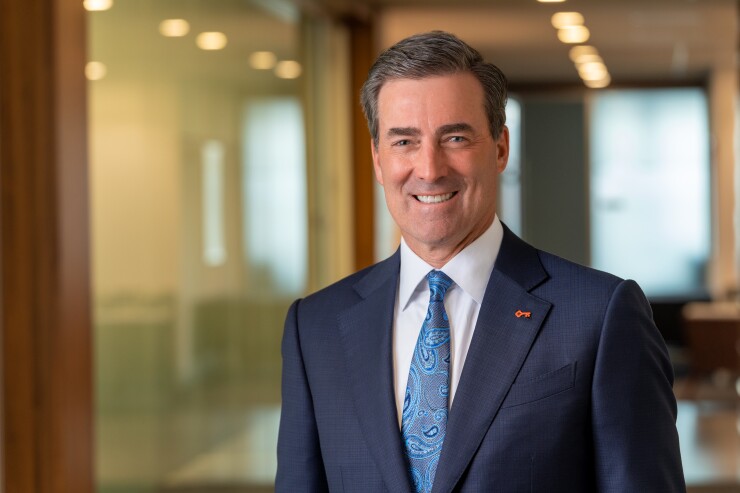
Cleveland-based KeyCorp reported second-quarter net income totaling $237 million Thursday, up 30% from the quarter ending March 31. The result, which was in line with analyst expectations, reflects modest net interest income growth, continued strong performance by fee-income business lines and tight control over expenses.
"This was a solid quarter for Key as we continued to execute on our clearly defined path to enhanced profitability," Chairman and CEO Chris Gorman said in a press release. "Sequentially, net interest income grew as we benefited from fixed asset repricing and continued to grow client deposits while the pace of deposit repricing slowed."
The $186.9 billion-asset Key produced "a better-than-expected core number, driven by fees and expenses," Scott Siefers, who covers the company for Piper Sandler, wrote Thursday in a research note.
Investors and some analysts, however, appeared to zero in on Key's loan portfolio. Their concerns helped push shares down about 3% in midday trading to $15.76. Though average yields increased five basis points in the quarter ending June 30, to 5.66%, the size of the loan portfolio continued to trend downward. Average loans totaled $109 billion on June 30, down about 2% from the three months ending March 31.
"Key is under-earning peers as the bank's net interest margin remains a third below prepandemic levels," Alexander Yokum, who covers the company for CFRA, wrote in a research note.
Gorman described loan demand as "tepid," while Chief Financial Officer Clark Khayat characterized Key's production as "a little weaker in the quarter than planned," on a conference call with analysts. Indeed, Key, which had previously predicted the loan portfolio would finish 2024 roughly in line with the year-end 2023 level of $112.6 billion, lowered its target Thursday, projecting a 4% to 5% year-over-year decline.
Still, both Gorman and Khayat said they saw reason for hope as Key enters the second half of 2024. Moreover, both reiterated existing guidance around net interest income, which projects a decline of 2% to 5% from the 2023 full-year total of $3.94 billion.

Gorman said on the conference call that he was "optimistic we'll start to see stabilization and potentially new growth" in loans in the second half of 2024. "Our pipelines are building," Gorman added. "In the middle market, our pipelines are over 50% higher than last quarter. In our institutional business, engagements, broadly, are picking up, as well."
Khayat said Key would benefit from the roll-off of $5.5 billion in low-yielding securities, along with increased revenue from its portfolio of swaps and treasuries.
"We expect net interest income will start to become a real tailwind next quarter and in the back half of the year," Khayat said.
At $899 million, second-quarter net interest income ticked up 1.5% from the first quarter. Fee income of $627 million declined 3% compared to March 31 levels, but Key's first-quarter numbers were driven by historically strong investment banking results. On a year-over-year basis, Key's second-quarter noninterest income was up 3%.
While second-quarter investment banking revenue failed to match the first-quarter level, deal pipelines continue to build, according to Gorman. "Our positive outlook for the [investment banking] business remains unchanged," Gorman said on the conference call. "Our pipelines today are higher than last quarter, year-end and year-ago levels."
Second-quarter operating expenses of $1.08 billion were down 6% from the first quarter and level with the second quarter of 2023. "Expenses continue to be well-managed," Gorman said.
Key reported increases in both net charge-offs and nonperforming assets, but its credit quality issues played out against a backdrop of industrywide normalization. Second-quarter net charge-offs of $91 million totaled 0.34% of total loans. Nonperforming loans totaled 0.66% of total loans on June 30, which Khayat, on the conference call, described as low. The pace of loans migrating into classified categories has slowed and should "continue to moderate and flatten out by the end of the year, assuming no material macro deterioration," Khayat added.
This story has been updated with comments from KeyCorp's second-quarter earnings conference call.






